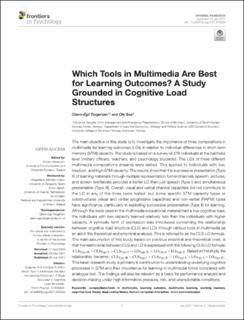| dc.contributor.author | Torgersen, Glenn-Egil | |
| dc.contributor.author | Boe, Ole | |
| dc.date.accessioned | 2022-03-23T13:39:35Z | |
| dc.date.available | 2022-03-23T13:39:35Z | |
| dc.date.created | 2020-11-30T17:14:22Z | |
| dc.date.issued | 2021 | |
| dc.identifier.citation | Torgersen, G.-E. & Boe, O. (2021). Which Tools in Multimedia Are Best for Learning Outcomes? A Study Grounded in Cognitive Load Structures. Frontiers in Psychology, 12, Artikkel 545335. | en_US |
| dc.identifier.issn | 1664-1078 | |
| dc.identifier.uri | https://hdl.handle.net/11250/2987123 | |
| dc.description.abstract | The main objective of this study is to investigate the importance of three compositions in multimedia for learning outcomes (LOs) in relation to individual differences in short-term memory (STM) capacity. The study is based on a survey of 378 individuals at the bachelor level (military officers, teachers, and psychology students). The LOs of three different multimedia compositions (means) were tested. This applied to individuals with low, medium, and high STM capacity. The results show that the successive presentation (Type II) of learning materials through multiple representation forms/channels (speech, pictures, and screen text/labels) provides a better LO than just speech (Type I) and simultaneous presentation (Type III). Overall, visual and verbal channel capacities did not contribute to the LO in any of the three tools tested, but some specific STM capacity types or substructures (visual and verbal progressive capacities) and non-verbal (RAPM) types have significance, particularly in exploiting successive presentation (Type II) for learning. Although the tools used in the multimedia educational material had a low cognitive load, the individuals with low capacity learned relatively less than the individuals with higher capacity. A symbolic form of expression was introduced concerning the relationship between cognitive load structure (CLS) and LOs through various tools in multimedia as an aid in the theoretical and empirical analyses. This is referred to as the CLS-LO formula. The main assumption of this study, based on previous empirical and theoretical ones, is that the relationship between CLS and LO is expressed with the following CLS-LO formula: CLSTypeIII>CLSTypeII>CLSTypeI→LOTypeIII>LOTypeI>LOTypeII. Based on this study, the relationship became: CLSTypeIII>CLSTypeI>CLSTypeII→LOTypeII>LOTypeI=LOTypeIII . This basic research study is primarily a contribution to understanding underlying cognitive processes in STM and their importance for learning in multimodal forms compared with analogue text. The findings will also be relevant as a basis for performance analysis and decision-making under high information pressure, risk, and unpredictable conditions. | en_US |
| dc.language.iso | eng | en_US |
| dc.rights | Navngivelse 4.0 Internasjonal | * |
| dc.rights.uri | http://creativecommons.org/licenses/by/4.0/deed.no | * |
| dc.title | Which Tools in Multimedia are best for Learning Outcomes? A Study Grounded in Cognitive Load Structures | en_US |
| dc.type | Journal article | en_US |
| dc.type | Peer reviewed | en_US |
| dc.description.version | publishedVersion | en_US |
| dc.rights.holder | © 2021 Torgersen and Boe. | en_US |
| dc.source.volume | 12 | en_US |
| dc.source.journal | Frontiers in Psychology | en_US |
| dc.identifier.doi | https://doi.org/10.3389/fpsyg.2021.545335 | |
| dc.identifier.cristin | 1854408 | |
| dc.source.articlenumber | 545335 | en_US |
| cristin.ispublished | true | |
| cristin.fulltext | original | |
| cristin.qualitycode | 1 | |

